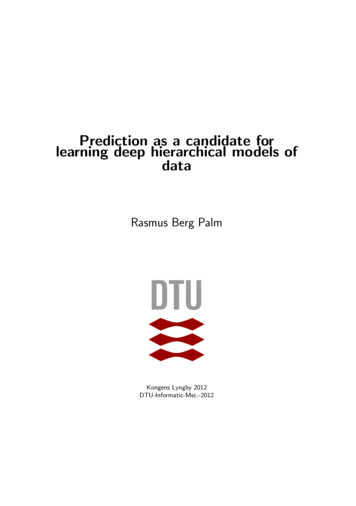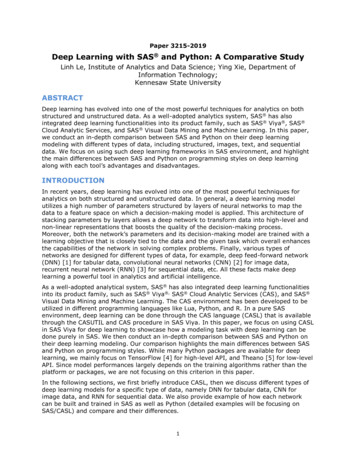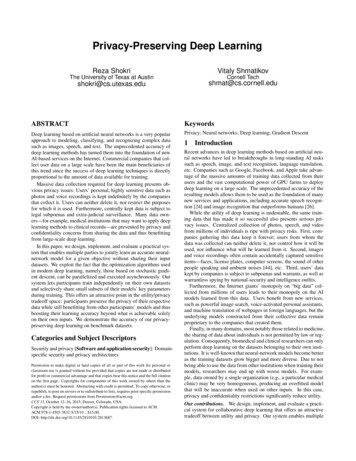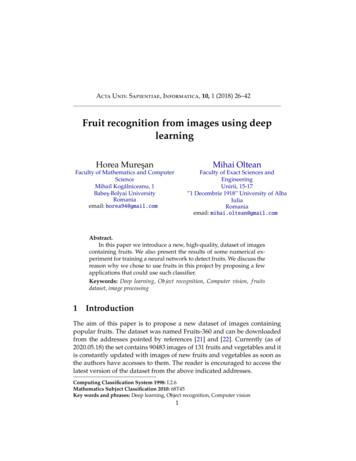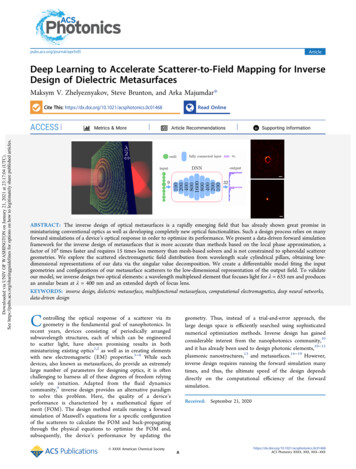
Transcription
pubs.acs.org/journal/apchd5ArticleDeep Learning to Accelerate Scatterer-to-Field Mapping for InverseDesign of Dielectric MetasurfacesMaksym V. Zhelyeznyakov, Steve Brunton, and Arka Majumdar*Cite This: nloaded via UNIV OF WASHINGTON on January 21, 2021 at 23:17:04 (UTC).See https://pubs.acs.org/sharingguidelines for options on how to legitimately share published articles.ACCESSMetrics & MoreRead OnlineArticle Recommendationssı Supporting Information*ABSTRACT: The inverse design of optical metasurfaces is a rapidly emerging field that has already shown great promise inminiaturizing conventional optics as well as developing completely new optical functionalities. Such a design process relies on manyforward simulations of a device’s optical response in order to optimize its performance. We present a data-driven forward simulationframework for the inverse design of metasurfaces that is more accurate than methods based on the local phase approximation, afactor of 104 times faster and requires 15 times less memory than mesh-based solvers and is not constrained to spheroidal scatterergeometries. We explore the scattered electromagnetic field distribution from wavelength scale cylindrical pillars, obtaining lowdimensional representations of our data via the singular value decomposition. We create a differentiable model fiting the inputgeometries and configurations of our metasurface scatterers to the low-dimensional representation of the output field. To validateour model, we inverse design two optical elements: a wavelength multiplexed element that focuses light for λ 633 nm and producesan annular beam at λ 400 nm and an extended depth of focus lens.KEYWORDS: inverse design, dielectric metasurface, multifunctional metasurfaces, computational electromagnetics, deep neural networks,data-driven designCgeometry. Thus, instead of a trial-and-error approach, thelarge design space is efficiently searched using sophisticatednumerical optimization methods. Inverse design has gainedconsiderable interest from the nanophotonics community,10and it has already been used to design photonic elements,10 12plasmonic nanostructures,13 and metasurfaces.14 19 However,inverse design requires running the forward simulation manytimes, and thus, the ultimate speed of the design dependsdirectly on the computational efficiency of the forwardsimulation.ontrolling the optical response of a scatterer via itsgeometry is the fundamental goal of nanophotonics. Inrecent years, devices consisting of periodically arrangedsubwavelength structures, each of which can be engineeredto scatter light, have shown promising results in bothminiaturizing existing optics1,2 as well as in creating elementswith new electromagnetic (EM) properties.3 8 While suchdevices, also known as metasurfaces, do provide an extremelylarge number of parameters for designing optics, it is oftenchallenging to harness all of these degrees of freedom relyingsolely on intuition. Adapted from the fluid dynamicscommunity,9 inverse design provides an alternative paradigmto solve this problem. Here, the quality of a device’sperformance is characterized by a mathematical figure ofmerit (FOM). The design method entails running a forwardsimulation of Maxwell’s equations for a specific configurationof the scatterers to calculate the FOM and back-propagatingthrough the physical equations to optimize the FOM and,subsequently, the device’s performance by updating the XXXX American Chemical SocietyReceived: September 21, 68ACS Photonics XXXX, XXX, XXX XXX
ACS Photonicspubs.acs.org/journal/apchd5ArticleFigure 1. Overview of method. (a.1) Sample forward designed metasurface. (a.2) Near-field response of metasurface for λ 633 nm. (b.1 4)Parsing the data. (b.1) Iterate through each pillar except the ones in the edges and gather the surrounding pillar radii. (b.2) Pillar radii and recordedand stacked into matrix R. (b.3) Field response in a square region with dimension of the pitch p corresponding to the central pillar. (b.4) Electricfields are vectorized and stacked into a matrix E. (c) We create a neural network that predicts a vector ω corresponding to the column of matrix.(d) W is constructed as the product ΣV*, where Σ and V are taken from the SVD of E.where ω is the angular frequency of the current source, ϵ(x) isthe dielectric permittivity distribution, μ(x) is the magneticpermeability distribution (assumed to be unity here as we willuse dielectric materials), and the vector x is the position vector.This implies that the field response ,⃗ (x) only depends on thedistribution of ϵ(x). A forward simulation of Maxwell’sequation thus entails the prediction of the spatial EM modesas a function of the scatterer geometry and position. Here, wefirst use high-fidelity EM simulations to generate data, whichare then used to find a simple mapping between ϵ(x) and ,⃗ (x),exploiting the singular value decomposition (SVD) and neuralnetworks.34 We note that a number of previous works usedneural networks to predict the spectral responses frommetallic35 37 and dielectric16,38 43 scatterers of various geometries. In these problems, the unit cells are identical and,hence, there is no need to invoke LPA. However, for imagingapplications, where the unit cells are spatially varying, invokingLPA results in inaccuracy. Our work aims to mitigate thischallenge by using a data-driven framework to predict thespatial responses from dielectric circular cylinders whileincluding the effects of their nearest neighbors. Another recentwork has applied data driven techniques to accelerate iterativefinite difference frequency domain (FDFD) solvers.44 Whileaccurate, this method is, however, still memory intensive. Ourwork provides an alternative, interpolative method forsimulating field responses from electromagnetic scatterers byfitting a differentiable model that maps the geometry of thescatterer and its closest neighbors to its EM field response.This model speeds up our forward simulation by estimatinglocal patches of the EM field from the radius of a cylindricalscatterer and its surrounding neighbors. We found that thismethod can simulate a mesh with 1.2 million discrete points104 times faster than conventional grid-based solvers and ismemory inexpensive enough that it can be run on a laptop. Weuse this framework to inverse design two devices, both ofwhich are unintuitive under the forward methodology: amultiwavelength metasurface that produces an annulus beamIn most existing design methods, Maxwell’s equations aresolved on a meshed grid, and refractive indices are allowed tochange at every point on this grid.10 16,20 These methods areaccurate and can simulate a scatterer of arbitrary shape;however, they do not scale well to large systems with smallfeatures due to the time and memory required to carry outeach forward simulation. In contrast, Mie-scattering-basedanalytical solutions17 19 scale better in time and memory, ascomputational cost only depends on the number of scatterersin each device, but they only work for highly restrictivegeometries. To date, only spherical17 and sparsely packedellipsoids18 can be simulated using Mie scattering for inversedesign. Another option is to rely on the local phaseapproximation (LPA),21 which assumes the EM properties ofa single scatterer can be characterized as a single complexvalued transmission coefficient that is a function of thescatterer geometry and independent from the geometries of thenearby scatterers. This approach requires solving Maxwell’sequations under Bloch boundary conditions with methodssuch as rigorous coupled wave analysis (RCWA).22 Suchmethods are fast but inaccurate when scatterers on ametasurface are not identical, which is especially apparentwhen geometries vary rapidly in space or when scatterers aremade from materials with low refractive indices.The objective of this work is to create a forward simulationmethod for inverse design that is faster than grid-basedmethods, is not restricted to spheroidal particles, and is moreaccurate than methods relying on LPA. We will leverageseveral data-driven modeling and machine learning techniques,23 which are being adopted in the field of optics andphotonics,24,25 with examples in fiber lasers26 32 andmetamaterial antennas.33The EM response ,⃗ to an incident current J⃗ is given byMaxwell’s equation: ,⃗ (x) ω 2 ϵ(x)μ(x),⃗ (x) iωμ(x)J ⃗ (x) 68ACS Photonics XXXX, XXX, XXX XXX
ACS Photonicspubs.acs.org/journal/apchd5due to minimal contributions to the total field power fromother vector components, which is a result of the circularsymmetry of the scatterers. However, the process could easilybe generalized to predict the entire vector-field. The resolutionof the simulation was chosen to be 0.04431 μm/vox in order tobalance computational time, memory requirements, andaccuracy. This results in (10 10) field points in each squareunit cell with a dimension p 443 nm corresponding to eachpillar.Once all of the field data were gathered, we constructed twomatrices: R 9 N for the radii and E 100 N for theelectric fields, with N being the number of scatterers. Thematrix R was created by iterating over pillar location xi, andstoring the radii of the pillar and its eight nearest neighbors as acolumn vector, shown in Figure 1b.1 and b.2. The pillars onthe edges of the metasurface do not have neighbors and wereneglected. Similarly, the matrix E was created by iterating overeach pillar location, extracting the field in the unit cell withcentroid xi, and storing it as a flattened 100 1 column vector,shown in Figure 1b.3 and b.4. We note that, in this paper, weconsider a scalar field, whose polarization axis is the same asthe incident polarization. This results in two matrices having N (113 2)2 10 123210 columns.Linear Regression Model. We first explore the lowdimensional structure of the matrix E, which will facilitatelearning a map between the columns of R and E. Patterns inthe rows and columns of E M N are extracted via thesingular value decomposition (SVD):34for one wavelength and focuses light at a different wavelengthas well as an extended depth of focus lens. METHODSThe goal of this work is to develop a fast and accurate proxyfor the forward simulation that is differential and may be usedfor inverse design. Figure 1 shows the schematic of our strategyto build a differentiable map F: 9 100 that predicts theelectric field over a square area with dimension p from thedielectric permittivity distribution ϵ(x), modeled as ninecylinders. Here p is the periodicity of the metasurface, andeach square area (unit cell) has been discretized into a 10 10grid. The corresponding field being predicted is flattened into a100 1 vector. We will explore two models: a low-dimensionallinear regression model based on the singular valuedecomposition (SVD) and a deep neural network model tofit F.Training Data. To train these models, we first generate adata set consisting of forward simulations of several physicaldevices, in our case lenses. These lenses were designed viaforward design. The intuition is that the lens is arguably thesimplest physical device and will likely provide a useful basis tointerpolate future devices. We forward designed 10 lenses ofdiameter 50 μm with focal lengths varying from 10 100μm.45 The lens design parameters are summarized in Table 1.Table 1. Parameters Used to Forward Design the TrainingData Setaparametervaluef10 100μmD50.0703μmp0.4431μmh0.633μmn2ArticleE UΣV *λ0.633μm(2)where U M M and V N N are unitary matrices, andΣ M N is a diagonal matrix, with non-negative entries onthe diagonal and zeros off the diagonal. The columns of U canbe thought of as a set of orthonormal basis vectors with whichto represent the columns of E. These columns of U arearranged hierarchically in terms of how much variance theycapture in E, as quantified by the corresponding diagonalelement of Σ. Figure 2a shows the square of the absolute valueof the first nine column vectors uj, reshaped from 100 1 to 10 10 . Definite patterns are observed in these vectors,implying a low-dimensional representation of our data. Therows of V* correspondingly provide a hierarchical basis for therows of E. Each column of the matrix ΣV* determines theexact combination of the columns of U required to reproducethe corresponding column of E.Guided by the SVD, it is possible to write an approximatematrix Ẽ asaf: focal length; h: height of the pillars; n: material index; λ: currentsource wavelength. The lens diameter D is chosen to be the closestinteger multiple of the periodicity p.All lenses are intended to function with a current sourcewavelength λ 0.633 μm. The material refractive index was setto n 2, corresponding to silicon nitride, our material ofchoice for visible wavelength operation.46 These dimensionscorrespond to exactly 113 pillars on each axis of themetasurface. All the scatterers were computed with RCWApackage S4.22 A sample lens of focal length f 50 μm is shownin Figure 1a.1. We simulated the EM response of each lensusing an x-polarized plane wave (λ 0.633 μm) with the fieldmonitor λ/2 away from the scatterers using Lumerical finitedifference time domain (FDTD) software. An example field isshown in Figure 1a.2. Only the ,x component was recordedFigure 2. Singular value decomposition of simulated data. (a) First nine left-handed singular vectors U of E matrix. (b) Singular value decay of thediagonal matrix Σ. Red circle represents the cutoff order we used to reconstruct the electric fields. The order 16 cutoff was chosen because itcaptures 99% total energy of the electric field. Any further contribution from modes with order q 16 contributes to less than 1% to the totalenergy in the field. (c) Plot of the absolute values squared of a random vector (ΣV*)i wi that reconstructs some random p p field. wi representsthe weights of the left-hand singular vectors ACS Photonics XXXX, XXX, XXX XXX
ACS Photonicspubs.acs.org/journal/apchd5Ẽ UqW(3)where W ΣqV*q , and the subscript q M is the truncationorder of the matrix approximation. The first q columns of Uare arranged to form Uq, the first q q sub-block of Σ isextracted to form Σq, and the first q rows of V* are taken toform V*q . It can be shown that Ẽ is the best rank qapproximation to the matrix E, in the Frobenius norm.47 Wechoose a truncation value of q 16, shown as the red circle inFigure 2b, as the rank 16 approximation Ẽ captures 99% of thevariance in the matrix E.We will now construct a regression map to estimate columnsof E from columns of R. Specifically, we estimate the matrix W,which will be used to reconstruct Ẽ . Instead of using thecolumns of R directly as features, we will create an augmentedfeature vector comprised of monomials constructed from theradii. This feature matrix Θ is constructed by verticallyconcatenating integer Hadamard powers of R:ÄÅÉÅÅ 1 ÑÑÑÅÅÑÑÅÅÅ R ÑÑÑÅÅÑÑÅÑΘ ÅÅÅÅ R 2 ÑÑÑÑÅÅÑÅÅ ÑÑÑÅÅÑÅÅ m ÑÑÑÅÅÇ R ÑÑÖ(4)where R m is the element-wise powers of R:ÉÄÅ mÅÅ r1,1 . r1,mN ÑÑÑÑÑÅÅÑÑÅÅR m ÅÅÅÅ ÑÑÑÑÑÅÅÅÅ r m . r m ÑÑÑÅÅÇ M ,1M ,N ÑÑÖFigure 3. (a) Column I represents the field simulated by FDTD,column II is the electric field predicted using the linear model, andcolumn III is the difference between the two. Each row represents thefield corresponding to the same set of 9 radii. (b) Probability densityfunctions of relative errors between the predicted matrix Epred and thetrue matrix E. The blue plot corresponds to a feature matrix with onlym 1, and the red plot represents the feature matrix constructed withpowers up to 10. (c) Plot of the relative errors in the Frobenius normbetween Epred and E. The x axis represents the power term in theradius features.Epred E testE test(5)(6)W ΞΘand solve for Ξ:Ξ WΘ†2F2F(9)as a function of m. Both plots show the error between ourmodel and the FDTD simulation decreasing as the number offeatures in each matrix increases, so the model converges to theactual physics of the system. The final relative error for thelinear model converged to 0.395. As a side note, we haveattempted using monomial expansions up to order 2 of columnvectors of R as input features for our model, by using powers ofcolumn vectors of R and cross terms in between radii, butfound no significant improvements in relative error whenfitting the model.Neural Network Model. To improve on the generalizedlinear model, we construct a deep neural network (DNN),shown in Figure 4. We hypothesize that the DNN would learna nonlinear transformation of the input features that bettercapture the physics of the system. The model was trained byusing 80% of the data set, while keeping 20% for validation.The architecture was implemented in TensorFlow48 andoptimized using the Adam optimizer.49 The DNN architectureconsists of 11 fully connected layers, each followed by a ReLUactivation function. The first layer of the network is the inputlayer with 9 neurons corresponding to each radius. The secondlayer has 100 neurons, which was doubled with eachsubsequent layer until 1600 and then cut in half until thesecond to last layer again had 100 neurons. The final layer had32 neurons, with the first 16 elements corresponding to thereal components of the vector w and the last 16 componentscorresponding to the imaginary components of wi. The outputswere arranged in this manner due to TensorFlow’s limitationswhen designing complex-valued neural networks. Theobjective function used was a mean squared error betweenthe output vector, and the corresponding vector from W,shown in detail in Figure 1c,d. The network was trained untilthe mean squared error of the verification data set stoppedbeing minimized in order to avoid overfitting. Once thenetwork was trained, we computed the electric field responseof the training data by feeding the test data set into the neuralnetwork to compute Wpred and eq 3 to compute Epred. Thequality of our prediction can again be summarized by therelative error between Epred and Etest in the Frobenius norm,given in eq 9, which was computed to be 0.26. The samemetric calculated by using a predicted field from the localThus, we set up a linear system:(7)†where the superscriptdenotes the Moore Penrosepseudoinverse.47 The matrix Ẽ can then be approximated bya generalized linear regression problem:Ẽ Epred ΞΘArticle(8)We varied the number of features used to train this linearmodel by changing the number of powers m used to constructΘ. To train this linear model, we used 80% of the data. Aftercreating W and Θ, we extracted a random set of 98568columns from each matrix in order to fit the matrix Ξ. We usedthe other 24642 columns for validation. Figure 3a depicts thequalitative performance of our linear model for m 10.Column I represents a randomly chosen vector Ei at someposition xi, column II is the corresponding predicted vectorepred Epred, and column III is the absolute difference squared ϵ 2 Ei epred 2. Note that we are comparing complexnumbers, while plotting their intensities. Thus, although theintensities may not look extremely similar, their errors can berelatively small. All values were normalized to have a maximumabsolute value of 1 and the same color bar across all figures.Figure 3b shows the probability density functions (PDFs) ofthe error distributions Epred E 2 as we increase m from 1 to10. As the number of features increases, the PDF becomestighter. Figure 3c is a plot of the relative error defined ACS Photonics XXXX, XXX, XXX XXX
ACS Photonicspubs.acs.org/journal/apchd5ArticleFigure 4. (a) Input into the DNN is 9 radii. The DNN architecture consists of nine fully connected layers. The first layer starts off with 100neurons, and each subsequent layer doubles the number of neurons until 1600, then number of neurons per layer is halved until the final layer has100 neurons. All layers are followed by a ReLU activation function. The output has 32 elements. (b) The performance of the DNN model. ColumnI is the field simulated by FDTD, column II is the field reconstructed by eq 3 from the predicted vector wi, and column III is the difference betweenfields.phase approximation gives a relative error of 1.35. We use theDNN model to inverse design our devices. As a side note, thesupplement includes a convergence study between number ofnearest neighbors included in the neural network model, andthe accuracy of the predicted near-field. The relative error ofour test data sets turned out to be lowest when using onlynearest neighbors.(( 2π )) is the parametriza-tion of a circle in the x y plane that we discretized over 20points on the circle. The factor of 20 on FOM633 is chosen as anormalization factor to ensure the integral of the intensity overthe annulus is the same as the intensity at the focal spot. Thequantity optimized was then max(FOM400, FOM 633)RESULTSTo test the utility of our model, we inverse designed two metaoptical devices. Motivated by stimulated emission depletion(STED) microscopy,50 the first device we inverse designed wasa wavelength multiplexed lens that focuses light with λ 633nm, and creates an annulus beam at the focal plan for λ 400nm. The second is an extended depth of focus (EDOF) lensthat focuses light over 100 350 μm along the optical axis. Theoptimization process was implemented in TensorFlow.48 Weused the DNN model and eq 3 to predict the near-fields of thedesigned devices. The far-fields were then calculated by usingthe angular propagation method.51 The gradients with respectto radii were calculated by using TensorFlow’s autodifferentiation, and updated by the adam optimizer.To design the multiwavelength lens, we had to predict nearfields for two wavelength. Hence, we repeated the procedureoutlined in Methods to create one more data driven model topredict the field response for a λ 400 nm current source. Thismodel was trained on the same data set as metasurface lensesdesigned to focus light for the 633 nm wavelength; however,the electric field responses were gathered from FDTDsimulations at 400 nm. Once trained, the relative error definedby eq 9 computed on the test data set for λ 400 nm was 0.37. The difference between the two wavelengths can beexplained by the relatively nonsmooth transmission of λ 400nm E-fields over this range of radii when compared to the λ 633 nm case. To optimize the lens, we defined two figures ofmerit for each wavelength as(12)with respect to the radii distribution. We set our initial radiusdistribution to be the same as the forward designed lens for λ 633 nm and f 50 μm. The designed device is shown in Figure5a. To verify the design, we computed the near-field responseFigure 5. (a) Optimized multifunctional device. Scale bar is 5 μm. (b)FDTD result for λ 0.4 μm. (c) FDTD result for λ 0.633 μm. Scalebars are 2 μm. Units are normalized so the maximum intensity is equalto 1.of the radii distribution in Lumerical FDTD and propagatedthe near-field to the focal plane using angular spectrummethod. Figure 5b,c shows the meta-optic’s response to 400and 633 nm wavelengths at the focal plane, respectively. Theefficiency η of the metasurface was calculated to be 26.82% forλ 400 nm. The formal definition is given in the supplement.We quantify the annulus functionality of the metasurface as theratio between the power confined in the annulus to the powerconfined in the center of the annulus. This ratio η wascalculated to be 58.47 for λ 633 nm, formally defined in thesupplement.The EDOF lens was designed by using a lens with f 100μm as a starting condition. Our intent was to design an EDOFlens to focus from 50 to 100 μm. We defined the figure ofmerit for the EDOF asiyi 2π yi 2π yFOM400 I jjjjc cosjjjm zzz, c sinjjjm zzz, 50 μmzzzzk 20 {k 20 {{m 0 k19(10)FOM633 20 I(0, 0, 50 μm)( 2π )spot. The tuple c cos i 20 , c sin i 20(11)where the function I(x, y, z) is the intensity of the electric fieldat (x, y, z) coordinate given byI(x , y , z) ,*(x , y , z),(x , y , z). The constant c 1.5 μm,corresponding to the radius of the annular beam at the focal10FOMEDOF log(I(0, 0, 50 m dz))m 468ACS Photonics XXXX, XXX, XXX XXX
ACS Photonicspubs.acs.org/journal/apchd5where dz 10 μm. Thus, we aim to maximize the intensity atthe center of 10 equispaced x y planes. The resulting device isshown in Figure 6a. The intent behind the logarithmic sumArticlefull FDTD simulation. Furthermore, adjoint optimizationrequires two simulation passes per optimization step, whichwill make the whole optimization process take at least 620 h.Even when considering the time it takes to gather the data andtrain our model, the overall design process is sped upsignificantly. The angular propagation step that transformsthe near-fields to the far-fields adds an additional 6 GB ofmemory and 26 s of optimization time to the optimizaton perfar-field plane used. For the EDOF lens, this results in anadditional 60 GB of memory required during the optimizationprocess. We note using a different propagation method such asthe Rayleigh Sommerfield method that does not requirestoring the full far-field, but only the field at the point wherethe FOM is calculated, would significantly reduce the memoryrequirements for the propagation.It is worth noting that our method is inherently interpolativeand, thus, is only as accurate as the data that we feed into it.Therefore, the current model is limited to predicting fieldsfrom lens-like devices, under a specific refractive index,constrained to a subspace of possible geometries. If onewanted to design a metasurface using this method for adifferent refractive index or with different scatterer geometries,the model would need to be retrained. One way we couldimprove this model is by using additional data to train it. Inour future work, we hope to improve the accuracy of thismodel by simulating random arrangements of scatterers andusing this as our training data set in addition to the data setfrom lenses. We also emphasize that the reported efficiency ofthe designed lenses is low, which remains a challenge for lowindex materials.52 However, full-wave simulations havereported an efficiency increase of the metasurface lenses,especially when all the coupling between scatterers are exactlyaccounted for.20,53 Our model could be improved by betteraccounting for the coupling between scatterers using moredata, especially EM field responses from scatterers with rapidlyvarying geometries, since the scatterer geometries of lensesvary slowly in space. One specific direction will be to capturethe physics to predict the full vectorial field, in contrast to thescalar field modeled here. Modeling the second nearestneighboring scatterers could also be an interesting pathforward. Utilizing techniques such as transfer learning,54 wecould utilize the features learned from our previous modelsthat include only information from the nearest scatterers andtry to generalize the model for second and even third nearestneighbors. Furthermore, adding additional constraints, such asassumptions about energy conservation to the model trainingprocess, could further increase the accuracy of the model.Figure 6. EDOF lens. (a) Device. (b) Simulated field. Simulation is aresult of FDTD and angular spectrum propagation. (c e) Slices offield in (b) along the dashed lines corresponding to 200, 250, and 300μm, respectively. The red dots are the simulated data. The blue linesare the Airy disk profiles corresponding to the diffraction limit. Allintensities are normalized by the corresponding maximum intensity.was to equalize the importance of each term along the z-axis.Without the logarithm term, the optimization would prioritizea single focal spot, since such a device would minimize thefigure of merit. After optimization, this figure of meritconverged to a lens focusing from 100 to 350 μm, as shownin Figure 6b, corresponding to a numerical aperture varyingfrom 0.07 to 0.25. We attribute the longer depth of focus thanwhat was intended to the physical nature of wave propagation.Figure 6c e shows slices of the electric field at 200, 250, and300 μm along the optical axis. The red dots correspond thesimulated data, and the blue line corresponds to the Airy diskcorresponding to the diffraction limited focal spot. We notethat clearly there are additional side-lobes in the EDOF design,and thus, the total energy in the main lobe suffers. However, adifferent figure of merit can be designed to reduce the sidelobes, depending on the desired application. DISCUSSIONThis paper outlines a data driven methodology for the forwardsimulation of Maxwell’s equations to design optical metasurfaces. Our model does not make the local phaseapproximation, and thus, the interscatterer coupling is wellaccounted for. While the model is not as accurate as acomplete full-wave simulation, it is significantly faster. A singleforward simulation of a square area of dimensions 50 μm 50μm at 44.31 nm resolution takes approximately 12 s with ourmethod versus approximately 3.1 h using Lumerical FDTDsoftware in the same computer. FDTD also requires a 58.95GB initialization mesh and 29.6 GB of RAM for the samesimulation, while our method only requires 3.75 GB for thesame problem and can be run on a mid-range laptop. It takesapproximately 16 h to gather the data required for training ourneural network model (10 FDTD simulations). Depending onthe design problem and based on our results from optimizationusing our DNN models as a forward simulator, it takesapproximately 100 iterations for an inverse design problem toconverge. Under these assumptions, we can estimate that wë gradientneed about 100 forward simulations to do a naivebased design, which would take 310 h to complete by using a ASSOCIATED CONTENT* Supporting Informa
several data-driven modeling and machine learning techni-ques,23 which are being adopted in the field of optics and photonics,24,25 with examples in fiber lasers26 32 and metamaterial antennas.33 The EM response ,⃗ to an incident current J⃗is given by Maxwell's equation: ,,⃗() ()() ()() 0xxxx xx ϵωμ ωμ2 iJ⃗ (1)


